10 Must-See Alternate Dog Movies:
Researchers would list out a lot of benefits in dog ownership/companionship. I mean sometimes one’s profound sadness can vaporize when looking at the strangely appealing eyes and long drooping ears of a dog. The way your canine pal scurries way when you are angry, or the way it dashes around in little circles vying for your attention, or the look it gives you when its forelegs are on the ground and head resting between them, dogs are the picture of unconditional love and adoration. The limited lifespan of a pet dog also teaches us a thing or two about death and grief.
Stories of dog ownership in cinema tend to mostly lurch toward the cute and cuddly. Of course, we need movies like Old Yeller (1957) or Marley & Me (2008) where our furry friends are at the center of ceaseless heart-warming entertainment. But the movie lists on our canine buddies can get a bit repetitive as we also need to look into those works featuring dogs that elicit more than the ‘awws’ and ‘oohs’.
For instance, in Amores Perros (2000), the brutal dog-fighting scenes remains as the metaphor for the savagery of modern capitalist life. In Paterson (2016), a tale of artfully constructed mundanity, a bulldog named Marvin’s towering, glowering presence that has its own charms. These are just two examples that immediately comes to my mind. And there are quite a few dog-driven narratives that are thought-provoking and emotionally involving without resorting to mawkishness. The intention of this weird-sounding movie list is to disclose such titles.
Notable Omission:
Goodbye To Language (2014)
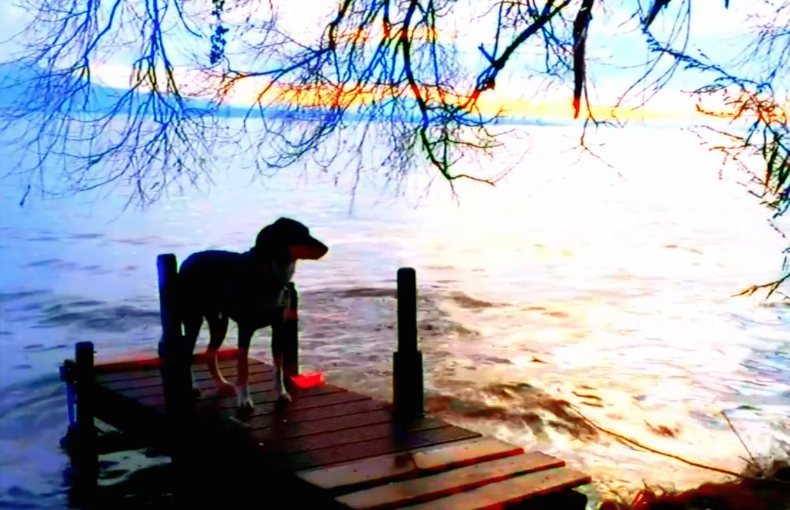
The then 84-year-old French New Wave master Jean-Luc Godard’s Goodbye to Language is less of a narrative cinema and more of an esoteric visual essay which may put some in a contemplative mood and will extract a vitriolic critique from others. The very slender narrative revolves around a bickering couple and a dog named Roxy – Godard’s beloved pet and also the film’s star. Winner of the Jury Prize at Cannes, the film is replete with disjointed soundtracks, sporadic cuts, and destabilizing visuals. Sly and humorous wordplays and quotations also accompany the juxtaposition of images. It is indeed a perplexing yet a mildly thoughtful portrayal of our broken, chaotic society. Perhaps the soulful part of the 70-minute essay-film is the grainy footage of friendly Roxy, freely playing around in nature, wandering between town and countryside and across the four seasons.
10. Euthanizer (2017)
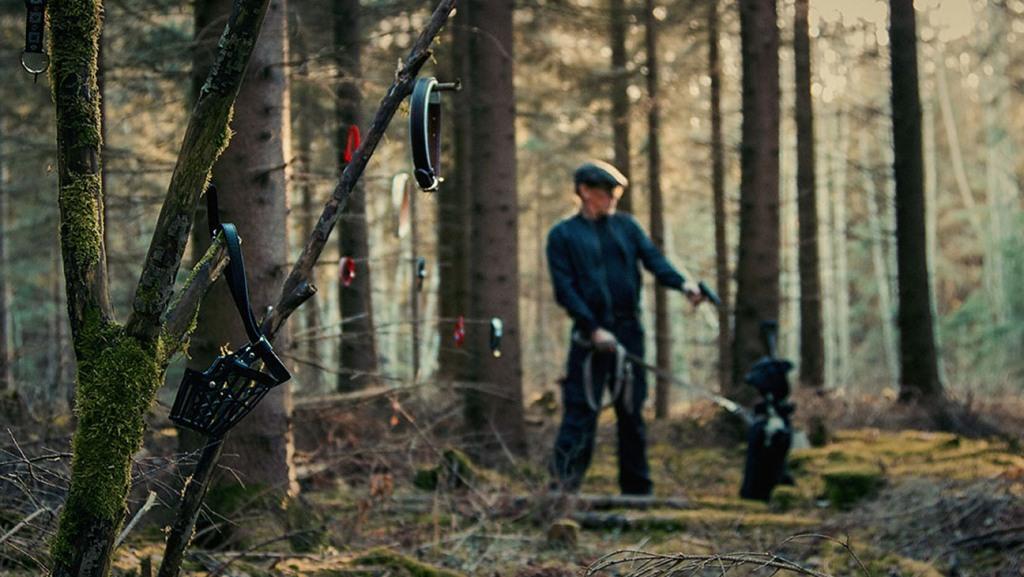
The basic idea for Teemu Nikki’s Finnish film is derived from the vigilante genre films of 1970s and 80s. But despite the B-movie exploitation genre vibe, Euthanizer has a fine emotional core and offers a poignant examination on suffering and cruelty. The story revolves around the fifty-year-old Veijo (the brilliant Matti Onnismaa, a veteran actor in his first leading role) who runs a broken-down auto-repair shop in a poor backwater region of Finland. He also carries out a side business as black-market pet euthanizer. Interestingly, Veijo happens to be an animal lover who claims to deeply understand and feel the pain of animals.
Veijo locks a dog owner in his dog’s kennel and straight-out refuses to put down a dog, whose owner he suspects is lying about the dog biting his child. However, when the owner badgers Veijo, he extracts more money and promises to put it to sleep. But Veijo simply takes in the dog as his own pet. The dog owner is a clumsy garage mechanic and member of a white supremacist gang. A nasty conflict ensues over the dog. Those who don’t flinch watching humans being subjected to violence on-screen, but bawl their eyes out while witnessing hints of on-screen violence directed against animals should be forewarned. Click here to read the full review.
9. Best In Show (2000)
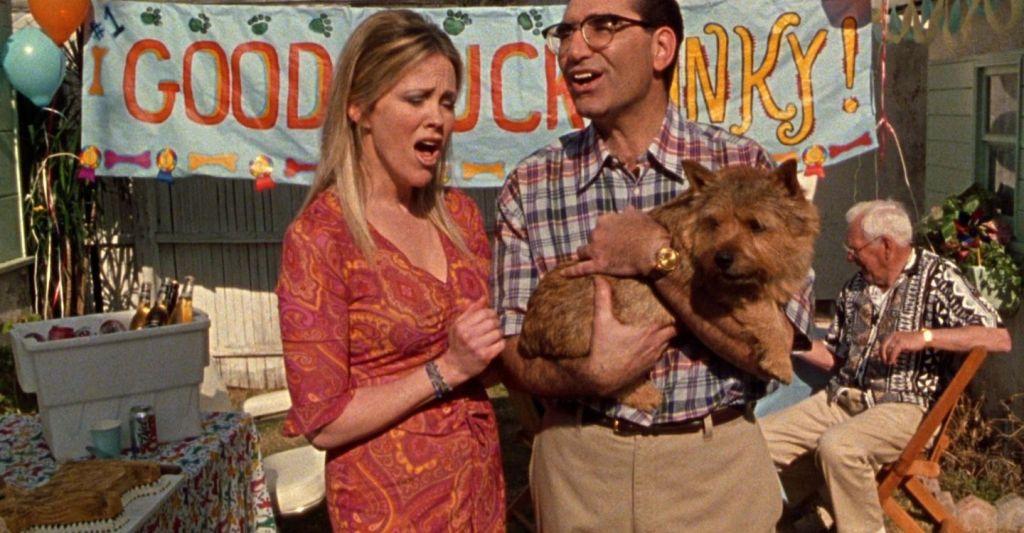
Even though Christopher Guest dislikes the term ‘mockumentary’ (mock-documentary), the writer/director and actor was the pioneer of this genre as he co-wrote (with Rob Reiner) the rib-tickling comedy centered on a goofy British heavy metal band, titled ‘This Is Spinal Tap’ (1984). Christopher Guest made his directorial debut with Waiting for Guffman (1996) in which he perfected the mockumentary form, deftly parodying American small-town eccentricities. Guest and his co-writer Eugene Levy ups the ante with Best In Show (2000), now not only making fun of the average oddball Americans but also hilariously inspecting the ways they idolize their pet dogs.
Best In Show has the classic two-act documentary structure, first introducing us to an assortment of everyday Americans, fervently preparing for the allegedly prestigious Mayflower Kennel Club dog show, and then brilliantly staging the show itself. Uptight yuppie couples, small-time dreamers from small-town, a voluptuous gold-digger, an affluent gay couple, a lonely country guy, and all of their unique dogs make sure that not a moment goes by in the narrative without laughs. Although Guest deals with stereotypes of a different kind, he effectively keeps it within biting satire range without making it so prejudicial.
Related to Must-See Alternate Dog Movies: The 10 Best Dog Movies of all Time
8. White God (2014)

Kondrel Mondruczo’s ‘Un Certain Regard’ award-winning (Cannes 2014) Hungarian drama is an apocalyptic fantasy and an angry sociopolitical allegory whose narrative revolves around mongrel madness. The tale is centered on teenager Lili (Zsofia Psotta) and her best friend/mixed-breed dog, Hagen. Refusing to pay the heavy tax levied by the government on mixed-breed dogs, Lili’s dad forcefully makes her to part ways with Hagen. Hagen and his homeless companions roam around the city, enduring numerous abuses from the human race. Eventually, the relentless discrimination pushes the canines to start a revolution.
There’s not much nuance in the metaphorical presentation. Director Mondruczo has stated that he ‘used dogs to symbolize minorities; as a metaphor about the European fears about dealing with minorities’. The idea for the film originated when it was supposed that Hungarian government may pass legislation to impose heavy tax on owners of dogs with mixed races than those of pure breeds. Mondruczo also hinted that an agonizing visit to the dog pound helped him in shaping up this narrative. Furthermore, White God was a visually interesting film which used a team of animal trainers and 250 dogs (brought from Hungarian animal shelters) to portray dog revolution rather than relying on CGI.
7. Quill: The Life of a Guide Dog (2004)

Maybe except for psychopaths, everyone would find puppies cute. They can be the perfect eye candy, waiting to be duly exploited by makers of sentimental dramas; the recipe for an entertaining yet very shallow Hollywood family drama. Yochi Sai’s Quill (2004) has a Labrador puppy at its narrative center, but the docu-drama approach here gives a naturalistic and deeply emotional feeling to the proceedings. Based on the novel of the same name, Quill is selected from a litter of pups to become a guide dog. After growing up under the care of a kind couple in his first year, Quill is taken to a training facility in order to train him to be the ‘seeing dog’ (to aid the visually-impaired).
Similar to Must-See Alternate Dog Movies: 5 Horse Racing Movies That Should Not Be Missed
Eventually, Quill is assigned an owner: a curmudgeon named Mr. Watanabe who is reluctant about taking in a guide dog. In the next few months, despite his protests, Mr. Watanabe begrudgingly acknowledges the companionship offered by Quill. Soon, Quill becomes the perfect friend and helper. Feline or canine protagonists, Japanese film-makers are adept at getting at the emotional truth despite a potentially contrived story. Hachiko Monogatari (1987) and The Adventures of Milo and Otis (1986) are a testament to that. Similarly, director Yochi Sai discards any unneeded emotional baggage and delightfully observes the dog in a naturalistic manner.
6. My Dog Tulip (2009)
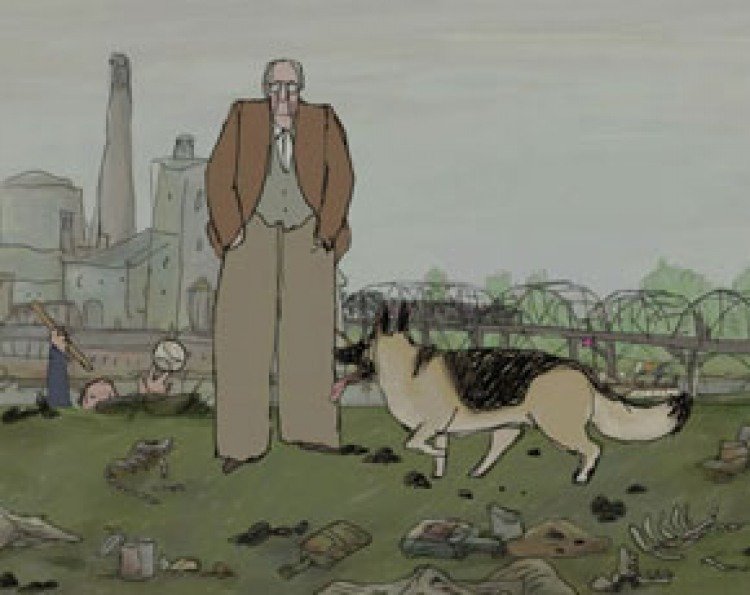
This painfully poignant tale of canine companionship was based on a memoir of author JR Ackerley (1896-1967), also the literary editor of BBC weekly magazine The Listener. Directors Paul & Sandra Fierlinger lend their intoxicating animated visuals to this 1956 book, weaving a visual poem out of a mundane pet dog ownership. Presented as a internal monologue, My Dog Tulip is replete with artfully visualized vignettes where the elderly author (ingenious voice performance by Christopher Plummer) describes the eccentricities and health issues of his German shepherd which he rescued from a brutal abode. Ackerly also acknowledges the unconditional love and companionship the dog has provided him for sixteen years, something that was lacking in his relationship with the human beings.
The best part of the imaginatively stylized feature includes Mr. Ackerly anthropomorphizing Tulip’s personality and adventures. Critic Roger Ebert was so fascinated by the movie that he concisely explains it in this way: “My Dog Tulip has no stupid plot, no contrived suspense. Tulip grows old and dies, as must we all. J.R. Ackerley misses her and writes a book about his loss. Through this dog, he knew love. And through J.R., so did Tulip.” Overall, it’s rare to find such intimate, down-to-earth, insightful feature on dog-human companionship.
In other Dog Movies – Isle of Dogs Review [2018]: Creating resonance through a language barrier
P.S. Those who admire My Dog Tulip must also see Laurie Anderson’s video essay movie titled Heart of a Dog in which the renowned multimedia artist celebrates her dog/companion Lolabelle’s life after it’s death.
5. White Dog (1982)
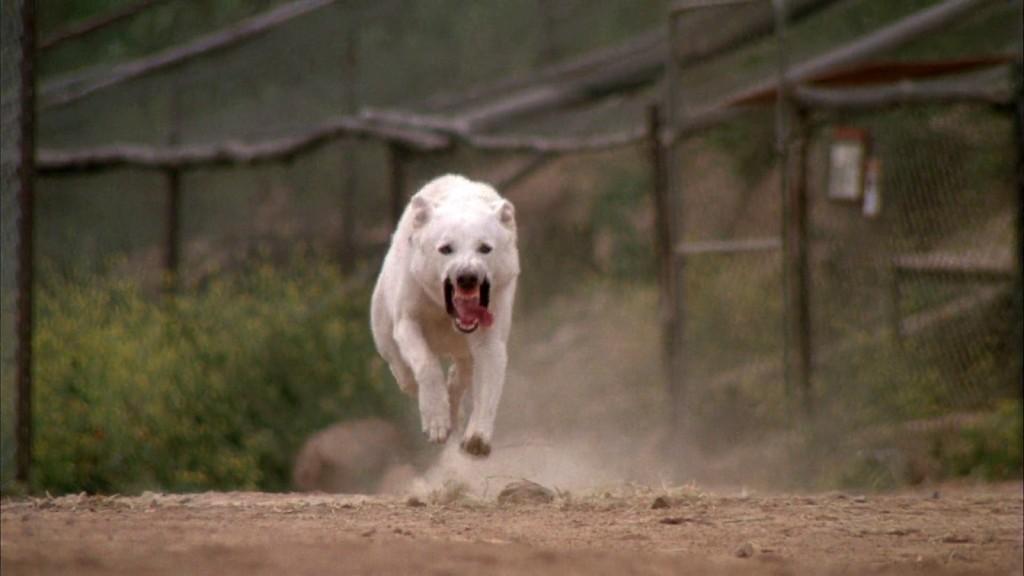
An aspiring young female actor, Julie Sawyer (Kristy McNichol) who lives in the Hollywood Hills hits a white German shepherd while driving back to home in the middle of the night. She takes it to a veterinarian and kind of adopts the handsome white dog. Her bond with the dog only strengthens when it saves Julie from a rapist by mauling him. But when the dog unexpectedly starts attacking Julie’s co-actor in the film set, she learns that it’s an attack dog. Dismissing the advice to put the dog ‘to sleep’, Julie seeks a trainer to cast out its viciousness. One of the canine experts who rent animals to Hollywood declares with a shock ‘It’s a White Dog!’ What he means is that a white racist has conditioned the dog to attack black people on sight.
An African-American animal trainer named Keys (Paul Winfield) who has had some experience with the white dogs, although no success as of yet, promises to give it a try. Directed by the daring American independent film-maker Samuel Fuller, White Dog was an incendiary and overtly metaphorical examination of the incurable condition of racism. Humans or dogs, feelings of hate can be deep-rooted, and the sad thing is there’s no vaccination for it.
4. Wendy and Lucy (2008)
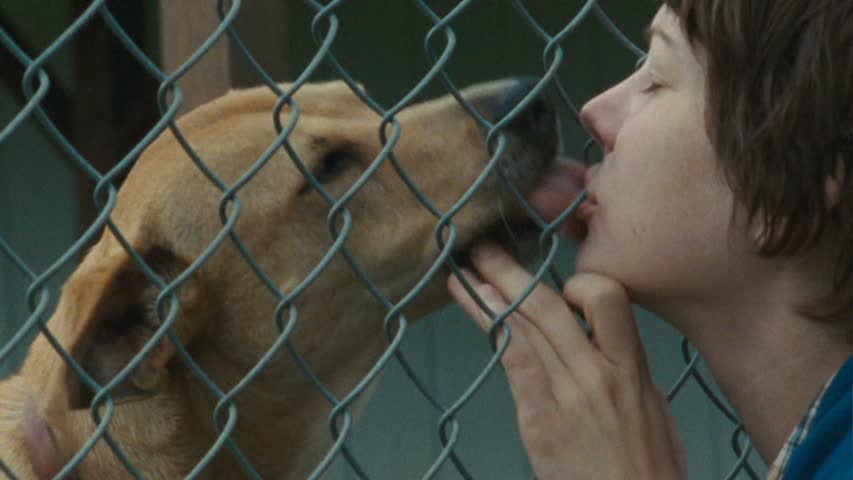
Kelly Reichardt’s independent arthouse drama offers a simple yet very memorable portrait of contemporary America. Traveling in a 1988 Honda from her hometown in Indiana to Ketchikan, Alaska, in search of a job, young woman Wendy (Michelle Williams) gets stranded in a derelict, former industrial small-town in Oregon with her beloved, mixed-breed dog Lucy. Obviously, she’s strapped for cash, now her car doesn’t start, and soon Wendy loses her dog after getting caught shoplifting dog food. Wendy and Lucy is a brilliantly restrained pensive drama, bolstered by an amazingly understated performance from Michelle Williams.
It might deal with a micro-tale of a how one set-back in the life of the impoverished can prove to be a catastrophe, but its implications can resonate all across the world (it was made during the Great Recession). The crux of the story naturally is Wendy‘s search for her heart-warming canine. Lucy is Wendy’s only companion in a society that has no need for her, even though some people are generous and compassionate in their own way. Director Reichardt unearths complex emotions and themes from the life of a young individual cast adrift in a time of economic desperation.
Also by Kelly Reichardt – Certain Women [2016]: Mumbai Film Festival Review
3. The Cave of the Yellow Dog (2005)
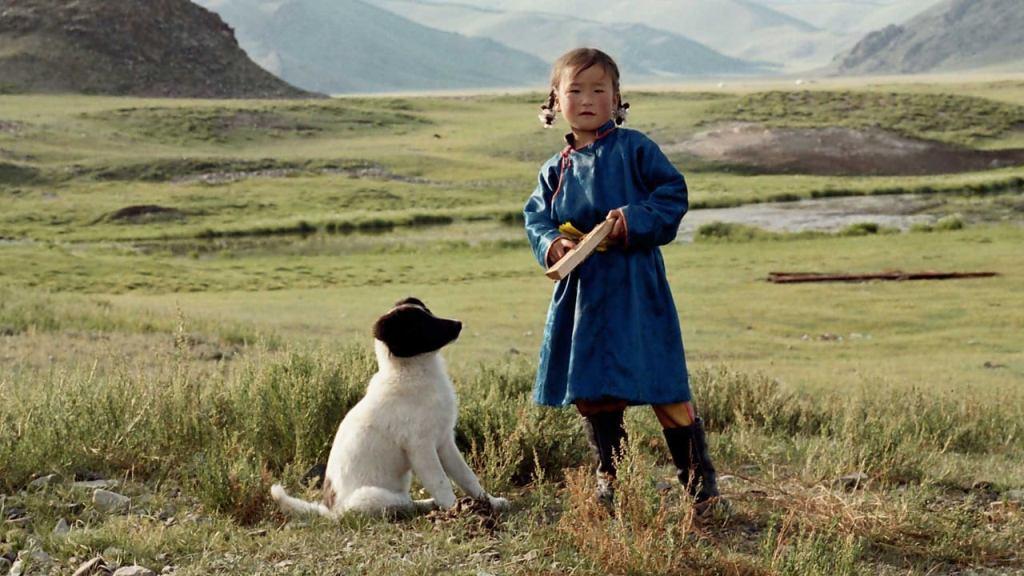
Byambasuren Davaa’s endearing ethnographic cinema showcases a way of life that’s fast disappearing as the long, spidery fingers of urbanization threatens to usurp the magnificence and simplicity of nomadic-life in the Mongolian steppe. The Cave of the Yellow Dog is a subtly dramatized account of a Mongolian herding family of five (mama, papa, and their three adorable little daughters) who play themselves. The eldest six-year-old Nansal upon returning from school goes to collect dung for fuel as the sheep are grazing near the pasture. She finds a tame, yellow dog in a cave, names him ‘Zochor’, and brings it to their yurt.
Dad, fearing that it might have lived with wolves, commands Nansal to take it back. Nansal disobeys her dad. What follows is a poetic observation of the little girl’s bond with her dog and the narrative also celebrates the quaint, idyllic Mongolian life-style. Three little girl-kids and a cute dog? Yes, the premise might seem to be overloaded with cuteness. Nevertheless, the writer/director maintains an air of unaffected naturalism throughout the narrative. Mongolian film-maker Davaa has also made two other wonderful docu-fictions: The Story of the Weeping Camel (2003) & The Two Horses of Gengis Khan (2009).
Similar to Dog Movies: Nanook of the North [1922] – A Quasi-Documentary Classic on the Ever-Smiling Eskimo
2. White Bim Black Ear (1977)

This tear-jerking Oscar-nominated Soviet drama is based on the book of the same name, written by Gavriil Troyepolsky. The touching drama is centered on a black-eared English setter which is saved from its imminent death by a widowed WWII war veteran, Ivan Ivanovich (played by the popular Russian actor Vyacheslav Tikhonov). Although the black ear is considered as an indication of the dog’s allegedly inferior breed standard, Ivan names it Bimka (Bim) and they get along pretty well. Nevertheless, problems for Bim begin when its master is hospitalized due to heart problems. The dog begins a quest to reunite with the master, but what follows is a tale of betrayal, tears, and kindness.
Though sounds like your regular cute and sad dog-movie, White Bim Black Ear intricately looks at the human condition through the eyes of a dog. The unconditional love Bim receives from the children as compared to cruelty inflicted upon him by the grown-ups tells us – the adults – what we can learn from dogs and kids. You feel that the ending of Lasse Hallstrom’s Hachi: A Dog’s Tale (2009) breaks your heart so much? Just wait until you see this film’s ending.
1.Umberto D. (1952)
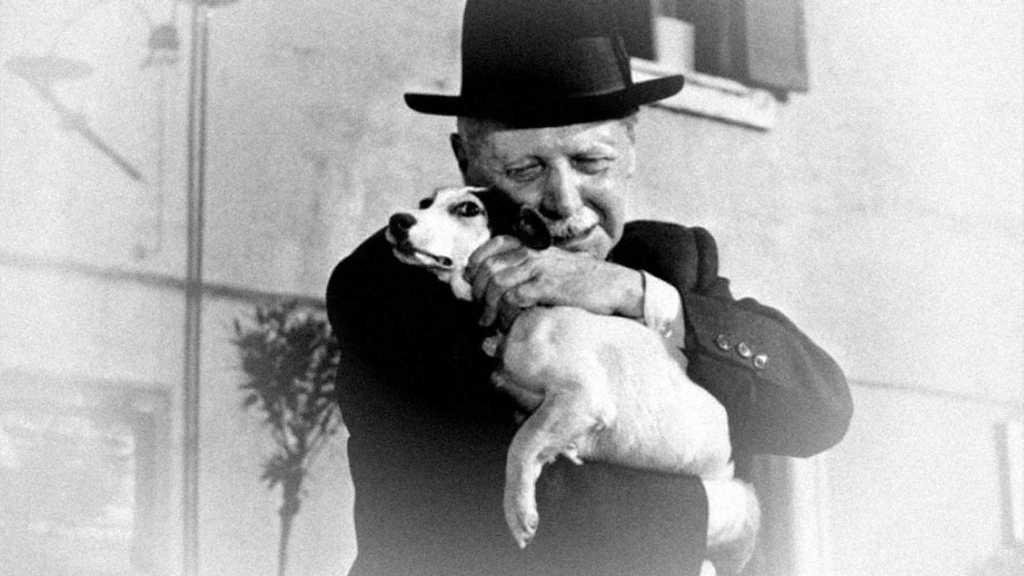
Vittorio De Sica’s Umberto D. (1952) was one of the timeless masterpieces of Italian neorealism cinema that observes a solitary old man’s determination to maintain his dignity, in the face of abject poverty. The film was critically panned and commercially failed during its release although it deservedly gained its masterpiece status in the later years. The titular old man’s (Carlo Battisti) only companion in life is his dog, Filke. Apart from his dog, the old man’s only other emotional connection in the world is a young, illiterate maid named Maria (Maria Pia Casilio).
Similar Read to Alternate Dog Movies: 25 Feel-Good Movies And Where To Watch Them
Although Umberto D. could be described as a drama about an old man and his dog, director De Sica directs it with a documentary-like precision where he never uses his visuals to manipulate viewer’s emotions. Two of the most memorable scenes in the narrative are: the scene Umberto goes in search of his lost dog at the dog pound (forlorn stray dogs are wheeled into gas chambers); and when he reluctantly resorts to begging with the help of Filke. In fact, the bond between Filke and Umberto is one of the artfully nuanced yet powerful depictions of man-dog relationships in the history of cinema.


